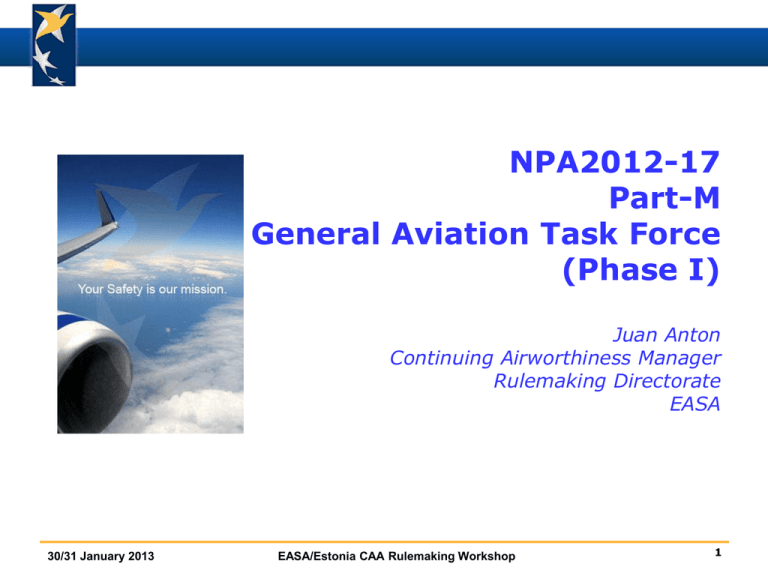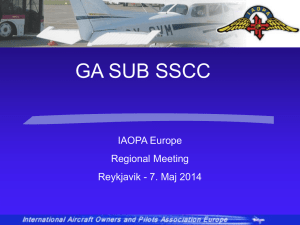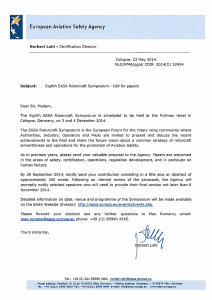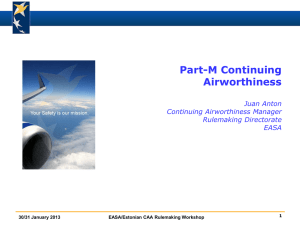ELA1 aircraft
advertisement

NPA2012-17 Part-M General Aviation Task Force (Phase I) Juan Anton Continuing Airworthiness Manager Rulemaking Directorate EASA 30/31 January 2013 EASA/Estonia CAA Rulemaking Workshop 1 Background In line with the requirements of the Basic Regulation, the Agency decided to perform an assessment of the impact of the implementation of the Part-M requirements in the General Aviation community. In order to obtain feedback on the effectiveness and proportionality of Part-M requirements for General Aviation, the Agency: - Initiated a survey on 04 July 2011, and - Organised a dedicated workshop in Cologne on 27 October 2011. 30/31 January 2013 EASA/Estonia CAA Rulemaking Workshop 2 Background Following this workshop the Agency decided to create a Task Force to address Part-M for General Aviation, representing the diversity of General Aviation. The objective of the Task Force was to discuss and agree on actions to reduce the burden on the General Aviation community, differentiating 2 phases: Phase I: Change Part-M to provide alleviations in areas where high costs and no real safety benefits have been identified, limited to issues not requiring a full regulatory impact assessment. In particular: Maintenance Programmes Airworthiness Reviews Phase II: Address other issues where further action is needed but where more technical discussions and a full regulatory impact assessment are required, consider feedback received for the 2011 workshop. This may include: Rulemaking, Standardisation, Change Management, etc… 30/31 January 2013 EASA/Estonia CAA Rulemaking Workshop 3 Task Force composition ORGANISATION Member AUSTRO CONTROL Andreas Winkler DGAC FRANCE Florence Leblond GAMA Joseph Sambiase EGAMA Jiri Duda IAOPA Dan Åkerman AEI Holger Möhrke ECOGAS Klaus Ardey EAS David G. Roberts EHA Ian Robinson LAMA-Europe Jan Fridrich European Sailplane Manufacturers Werner Scholz EASA / Rulemaking Juan Anton EASA / Rulemaking Régine Hamelijnck EASA / Certification Jannes Neumann EASA / Standardisation Mark Kieft 30/31 January 2013 EASA/Estonia CAA Rulemaking Workshop 4 Phase I approach « Bottom-up » approach ELA 1/ELA 2 aircraft not used in commercial operations Airworthiness Review 30/31 January 2013 Maintenance Programme EASA/Estonia CAA Rulemaking Workshop 5 NPA proposals (Phase I) Proposal Scope Possibility for the owner to contract the development and approval processing of the MP to a Part-145 or M.A. Subpart F maintenance organisation, being also possible for this organisation to use the 1 indirect approval procedure (if approved by the competent authority). NOTE: The contracted maintenance organisation must be under the oversight of the State of Registry of the aircraft. Possibility for the owner to issue a declaration for his/her own aircraft’s MP. 2 NOTE: In this case, the owner takes full responsibility for its content and any deviations from the Design Approval Holder recommendations. Introduction of “Minimum Inspection Programmes” (Appendix IX to Part-M) which may be used by the owner as the basis for the declared MP. Applicable to: 3 ELA1 aeroplanes not involved in commercial operations ELA1 sailplanes and ELA1 powered-sailplanes not involved in commercial operations ELA1 balloons not involved in commercial operations 30/31 January 2013 EASA/Estonia CAA Rulemaking Workshop ELA2 aircraft not involved in commercial operations* ELA1 aircraft not involved in commercial operations See left column 6 NPA proposals (Phase I) Proposal Scope All aircraft except Introduction of a template which may be used in order to prepare a complex 4 customised MP for a particular aircraft registration. motorpowered aircraft Possibility for a Part-145 or M.A. Subpart F maintenance organisation to perform the airworthiness review and issue the ELA1 aircraft corresponding ARC (airworthiness review certificate) at the same not involved in 5 time they perform the annual inspection contained in the “Minimum commercial Inspection Programme” operations NOTE: A new Form 15c (ARC) has been introduced to cover this case. All aircraft Clarification that, depending on the scope of work, the organisation maintained by 6 may not need to have a hangar available and may use alternative M.A. Subpart F suitable facilities (AMC M.A.605(a)). MOs Introduction of guidance related to the use of the indirect approval 7 procedure by a CAMO in order to introduce new type ratings to their All aircraft scope of work (AMC M.B.703) 30/31 January 2013 EASA/Estonia CAA Rulemaking Workshop 7 ELA1 and ELA2 definitions “ELA1 aircraft” means the following manned European Light Aircraft: (i) an aeroplane with a Maximum Take-off Mass (MTOM) of 1200 kg or less that is not classified as complex motorpowered aircraft; (ii) a sailplane or powered sailplane of 1200 kg MTOM or less; (iii) a balloon with a maximum design lifting gas or hot air volume of not more than 3400 m3 for hot air balloons, 1050 m3 for gas balloons, 300 m3 for tethered gas balloons; (iv) an airship designed for not more than four occupants and a maximum design lifting gas or hot air volume of not more than 3400 m3 for hot air airships and 1000 m3 for gas airships; This definition was adopted in Regulation (EU) 593/2012 (dated 05 July 2012) and is not subject to discussion in this NPA. 30/31 January 2013 EASA/Estonia CAA Rulemaking Workshop 8 ELA1 and ELA2 definitions “ELA2 aircraft” means the following manned European Light Aircraft: (i) an aeroplane with a Maximum Take-off Mass (MTOM) of 2000 kg or less that is not classified as complex motor-powered aircraft; (ii) a sailplane or powered sailplane of 2000 kg MTOM or less; (iii) a balloon; (iv) a hot air ship; (v) a gas airship meeting all of the following elements: - 3% maximum static heaviness, - Non-vectored thrust (except reverse thrust), - Conventional and simple design of: structure, control system and ballonet system - Non-power assisted controls; (vi) a Very Light Rotorcraft. This definition was adopted in Regulation (EU) 748/2012 (dated 03 August 2012). It is introduced in the NPA in order to incorporate it into (EU) 2042/2003 but its content is not subject to discussion in this NPA. 30/31 January 2013 EASA/Estonia CAA Rulemaking Workshop 9 Proposal 1: MP contract to 145 or MF organisation Currently, the owner of a non-large aircraft not used in commercial operations has 3 options: 1) manage the continuing airworthiness of the aircraft himself/herself without contracting a CAMO (full responsibility). 2) contract all the tasks associated with continuing airworthiness to a CAMO, transferring the responsibility for the proper accomplishment of the tasks to the CAMO. 3) contract only the development and approval processing of the maintenance programme to a CAMO. In options 2) and 3), the approval of the maintenance programme may be performed by the CAMO through an indirect approval procedure (see AMC M.A.201(e)). New option for ELA2 aircraft not involved in commercial operations: 4) contract the development and approval processing of the maintenance programme to a Part-145 or Subpart F maintenance organisation located in the Member State where the aircraft is registered. In this option, the approval of the maintenance programme may be performed by the maintenance organisation through an indirect approval procedure (see AMC M.A.201(e)). 30/31 January 2013 EASA/Estonia CAA Rulemaking Workshop 10 Proposal 2: Declaration of the MP by the owner Currently, the MP is approved either by the NAA of the State of Registry or by the contracted CAMO via an indirect approval procedure approved by the competent authority of the CAMO/operator (M.1, paragraph 4). New option for ELA1 aircraft not involved in commercial operations: The owner may issue a declaration (no NAA approval) for the MP subject to compliance with the conditions described in M.A.302(h). 30/31 January 2013 EASA/Estonia CAA Rulemaking Workshop 11 Proposal 2: Declaration of the MP by the owner If the owner elects to issue a declaration for the MP: The owner is fully responsible for its content and, in particular, for any deviations from the Design Approval Holder’s recommendations. The NAA and the contracted CAMO do not have any responsibility related to its content. It is not required to send a copy of the MP to the NAA (no further checking of the content by the NAA) This MP will be the basis for the adequate planning of maintenance and for the airworthiness reviews and ACAM inspections. Nevertheless, the MP will be subject to periodic reviews: - Annual or at the time of the airworthiness review. NAA notified in case of deficiencies in the content of the MP. The owner shall amend the MP. 30/31 January 2013 EASA/Estonia CAA Rulemaking Workshop 12 Proposal 3: “Minimum Inspection Programmes” Currently, the MP for a particular aircraft registration will use as a basis, and among other aspects, the data issued by the Design Approval Holder (TC holder, STC holder, etc.). New option for ELA1 aircraft (except airships) not involved in commercial operations: The owner may use the “Minimum Inspection Programmes” (Appendix IX to Part-M) as the basis for the declared MP. NOTE: The MP still has to be customised to the particular aircraft registration (see M.A.302(h) and the template contained in AMC M.A.302(e)) 30/31 January 2013 EASA/Estonia CAA Rulemaking Workshop 13 Proposal 3: “Minimum Inspection Programmes” Important aspects about this new option: This option (using “Minimum Inspection Programmes”) can only be used if the owner will issue a declaration for the MP (not possible if the MP will be approved by NAA or via indirect approval procedure). The owner still has the option to base the MP on data issued by the Design Approval Holder (DAH). With this option, the owner can issue a declaration for the MP or have it approved by the NAA or via indirect approval procedure. If the owner has contracted a CAMO or Maintenance Organisation to develop the MP, but the owner is going to eventually issue a declaration for the MP The MP may be based on the “Minimum Inspection Programmes”. However, the contracted organisation has to propose a MP which includes: - The mandatory maintenance information - Any additional tasks derived from the evaluation of the DAH recommendations The owner assumes full responsibility for any deviations introduced 30/31 January 2013 EASA/Estonia CAA Rulemaking Workshop 14 Proposal 3: “Minimum Inspection Programmes” Important aspects about the “Minimum Inspection Programmes”: Separate tables have been created for: ELA1 aeroplanes ELA1 sailplanes and ELA1 powered sailplanes ELA1 balloons For aeroplanes and TMG (Touring Motor Gliders): annual/100h interval (with 10h tolerance). For sailplanes, powered sailplanes (other than TMG) and balloons: annual interval. Weighing per Part-NCO of Annex VII to the future Regulation on Air Operations. The manufacturer’s maintenance manuals must be used to accomplish the specific maintenance instructions. For the customised MP the owner has to take into account, in addition: Specific inspections contained in the DAH data with interval different from 100h and/or annual Other specific recommendations from the DAH Additional inspection required by the DAH for high utilization aircraft 30/31 January 2013 EASA/Estonia CAA Rulemaking Workshop 15 Proposal 4: Template for the customised MP Current rules and AMC/GM material do not provide detailed information on how to customise the MP, creating different approaches among Member States. New template for all aircraft except complex motor-powered aircraft: This template is contained in AMC M.A.302(e) and referred to in AMC M.A.302(h). It is a mean to comply with M.A.302(e) and M.A.302(h). SEE THE TEMPLATE FOR DETAILED INFORMATION 30/31 January 2013 EASA/Estonia CAA Rulemaking Workshop 16 Proposal 5: Airw. Review by Maintenance Organisation Currently, Airworthiness Reviews can only be performed by CAMOs or NAAs. Only for ELA1 non commercial, independent certifying staff can perform it (but they can only issue a recommendation) New option for ELA1 aircraft not involved in commercial operations: The maintenance organisation (145 or Subpart F) which is performing the annual inspection contained in the “Minimum Inspection Programme” may, simultaneously, perform the Airworthiness Review and issue the ARC (new Form 15c). 30/31 January 2013 EASA/Estonia CAA Rulemaking Workshop 17 Proposal 5: Airw. Review by Maintenance Organisation Important aspects about this new option: The maintenance organisation has to nominate airworthiness review staff. - - These staff must: Hold a certifying staff authorisation for the aircraft reviewed. Have 3 years experience as certifying staff of ELA1 aircraft. Be independent from the airworthiness management process or have overall authority (for that aircraft). Have knowledge of the areas of Part-M linked to continuing airworthiness management. Have knowledge or the organisation’s procedures relative to airworthiness review and issuance of the ARC. Performed at the same time as the annual inspection and by the same person releasing it. It is possible for the maintenance organisation to perform the Airworthiness Review and issue the ARC, but it is not possible for them to extend the ARC (since they do not manage the continuing airworthiness of the aircraft). 30/31 January 2013 EASA/Estonia CAA Rulemaking Workshop 18 Proposal 6: No need for availability of a hangar AMC M.A.605(a) has been amended in order to cover cases such as a Subpart F maintenance organisation maintaining sailplanes (when not performing major repairs), allowing the use of alternative suitable facilities instead of a hangar. 30/31 January 2013 EASA/Estonia CAA Rulemaking Workshop 19 Proposal 7: Indirect approval by CAMO of the scope of work AMC M.B.703 has been amended to clarify that: - It is possible for the NAA to endorse in the Form 14 (approval certificate) a scope of work for a certain aircraft group (example, Group 3), while the scope of work defined in the manual (CAME) does not include all Group 3 aircraft. - In this case, the NAA should be satisfied that the CAMO has the capability to manage the full Group 3. However, Baseline/Generic MP or individual MP (for contracted customers), are only needed for those aircraft types included in the detailed CAME scope of work. - Changes to the scope of work in the manual (CAME) not affecting the Form 14 (example, the addition of a new aircraft type within Group 3) could be approved by the CAMO via an indirect approval procedure. - It is at that time when the Baseline/Generic MP or individual MP (for contracted customers) must be available for the new aircraft types. 30/31 January 2013 EASA/Estonia CAA Rulemaking Workshop 20





